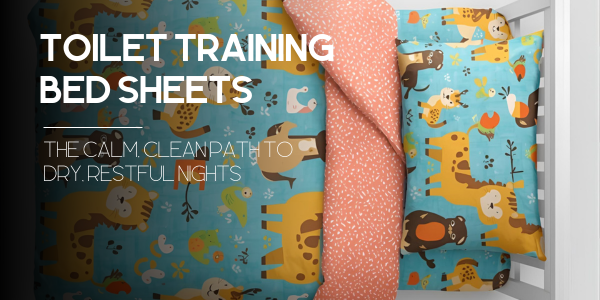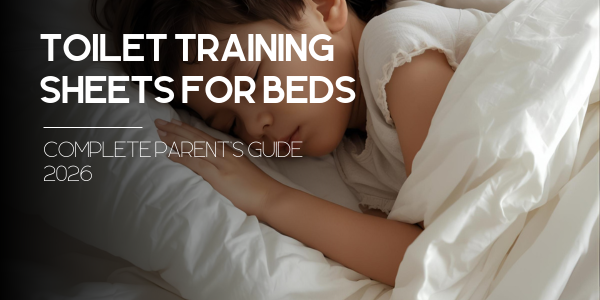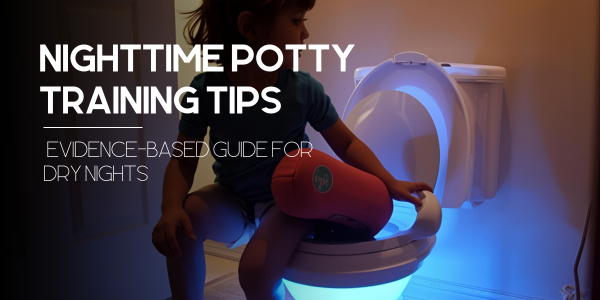Potty Training Bed Pads: Protecting Your Child's Confidence While They Sleep
The Complete Guide to Potty Training Bed Pads: Protecting Your Child's Confidence While They Sleep
Because 5 million families can't all be wrong — and neither are you for being here
Breaking the Silence on a Common Journey
Let's start with a number that might surprise you. Ready? Around 20% of children have some problems with bedwetting at age 5, and up to 10% still do at age 7. That's not a typo. That's millions of families dealing with the exact same challenge you're facing right now.
Yet here's the kicker — nobody talks about it. Not at playdates. Not at school pickup. Definitely not on those perfect-family Instagram posts. It's like there's this massive conspiracy of silence around something that affects literally one in five kids.
Here's what we promise: By the time you finish reading this guide, you'll have everything you need to transform those anxious 2 AM wake-ups into peaceful, confident nights. No judgment. No shame. Just real solutions that actually work.
Look, we get it. You're probably exhausted from midnight sheet changes. Maybe worried about your child's self-esteem. Possibly calculating how much you've spent on laundry detergent this month alone. (Spoiler: it's probably enough for a nice dinner out.)
That's exactly why Chooniez exists. We're not just selling products — we're offering peace of mind, one dry night at a time.
The Science Behind Bedwetting: Understanding Before Acting
The Numbers That Matter (And Why They Should Comfort You)
Here's something fascinating — boys are 2-3 times more likely to experience bedwetting than girls. And if you or your partner wet the bed as a kid? There's a 44% chance your child will too. If both of you did? That jumps to 77%. It's literally in the genes, folks.
Why Bedwetting Happens (Spoiler: It's NOT Your Child's Fault)
Okay, time for some real talk. Your kid isn't wetting the bed because they're lazy. Or defiant. Or trying to get attention. Nope, not even a little bit.
Here's what's actually happening in that little body:
Picture this: Your child's bladder is like a really quiet friend trying to wake them up at a sleepover. Some kids' brains just need that friend to shout a little louder before they notice. The signal pathway between bladder and brain is still developing — it's like their internal alarm system is on silent mode.
There's this hormone called vasopressin (fancy name, right?). It's basically your body's "don't pee at night" chemical. Some kids just don't produce enough of it yet. Think of it like their body's night shift manager hasn't shown up for work.
You know how your kid could sleep through a fire alarm? Yeah, that. Some children are such deep sleepers that their brain literally doesn't register the "gotta go" signal. It's actually a sign of healthy, restorative sleep — just with an unfortunate side effect.
Plot twist: A full bowel can press against the bladder, reducing its capacity. It's like trying to inflate a balloon in a box that's too small. Many parents don't realize that addressing constipation can significantly improve bedwetting. Mind. Blown.
The Hidden Emotional Cost (The Part That Really Matters)
Brace yourself for this one. Research shows that children rank bedwetting as the third most distressing life event — right after parental divorce and fighting. Let that sink in for a moment.
It ranked higher than being bullied. Higher than failing a test. Higher than losing a pet. That's how much this impacts our kids emotionally.
When my daughter told me she didn't want to go to her best friend's sleepover because of her 'problem,' my heart broke. That's when I knew we needed more than just another waterproof sheet.
And here's the financial kicker — families spend up to $1,000 annually on damaged bedding alone. That's not counting the water bills, the extra detergent, the mattress replacements... you get the picture.
When to Seek Help: Red Flags Every Parent Should Know
Look, we're not trying to freak you out here. Most bedwetting is totally normal developmental stuff. But sometimes — just sometimes — it's your kid's body waving a little flag saying "Hey, check this out!"
The Age Guidelines (Without the Judgment)
Here's the straight scoop: If your child was fully potty-trained by 3 and suddenly starts having accidents at 4 or 5? That's worth a conversation with your pediatrician. Not a panic-inducing emergency room visit — just a chat.
The magic age most docs care about? Six years old. If bedwetting is still happening regularly after age 6, it's time to explore your options beyond waiting it out.
Warning Signs That Need Attention (Like, Actually Need It)
See a doctor immediately if your child has:
- Pain or burning during urination
- Blood in their urine (even a tiny bit)
- Excessive thirst or sudden weight loss
- Daytime accidents after being dry for months
- Swelling in feet or ankles
But here's what parents often miss — the emotional red flags. If your kiddo is showing signs of anxiety, withdrawing from activities, or their self-esteem is taking a nosedive? That's just as important as the physical stuff.
Potty Training Bed Pads: Your Family's First Line of Defense
Alright, let's talk solutions. Real, practical, works-at-3-AM solutions.
How Bed Pads Work: The Technology Behind the Protection
Modern bed pads aren't your grandma's rubber sheets (thank goodness). Those crinkly, sweaty nightmares are ancient history. Today's pads are engineering marvels — seriously!
Picture a high-tech sandwich:
- Top Layer: Soft, breathable fabric that feels like regular bedding
- Middle Layer: Super-absorbent core that can hold up to 2 liters (that's a big bottle of soda, folks)
- Bottom Layer: Waterproof barrier with grip technology
The science behind modern bed pads is actually pretty cool. They use something called "wicking technology" — liquid gets pulled away from the surface and locked into the core. Your kid stays dry, the mattress stays protected, everyone wins.
Disposable vs. Reusable: The Great Debate Solved
Time for some real talk about the elephant in the room. Or should we say, the pad on the bed?
| Factor | Disposable Pads | Reusable/Washable Pads |
|---|---|---|
| Initial Cost | $20-30 per pack | $40-80 per pad |
| Annual Cost | $300-500 | $80-160 (one-time) |
| Environmental Impact | High (centuries to decompose) | 71% less energy consumption |
| Convenience | Grab and toss | Wash and reuse |
| Durability | Single use | 300-500 washes |
| Travel-Friendly | Very (lightweight) | Moderate (need washing) |
| Comfort | Can feel plasticky | Soft, fabric-like |
Here's our hot take: Reusable pads pay for themselves in 2-3 months. Plus, you're not contributing to that giant island of garbage floating in the Pacific. Win-win!
But hey, we get it — sometimes you need the convenience of disposables for travel or those extra-rough weeks. No judgment here. Do what works for your family.
The Parent's Buying Guide: Choosing the Right Bed Pad
Shopping for bed pads shouldn't require a PhD in Material Science. Let's break it down, parent to parent.
Key Features That Actually Matter
Absorption Capacity (AKA: How Much Can This Thing Handle?)
Material Considerations (Because Sensitive Skin Is Real)
Not all pads are created equal. Some kids have skin more sensitive than a reality TV star's ego. Hypoallergenic options are game-changers for these little ones.
What to look for:
- 100% cotton top layer (breathable and soft)
- TPU backing instead of vinyl (less sweaty)
- Chemical-free certifications
- No fragrances or dyes
Practical Features (The Stuff That Makes Life Easier)
Tuckable wings or flat design? Here's the deal — wings are great for active sleepers who toss and turn like they're auditioning for Cirque du Soleil. Flat pads work fine for calmer sleepers and are easier to layer (more on that genius hack later).
Age-Specific Recommendations
These tiny humans are just figuring out this whole "no diaper" thing. They need maximum coverage and fun designs that make bedtime less scary. Our colorful throw blankets work great for couch protection during daytime potty training too!
This age is all about independence. They want to help with cleanup, choose their own products, and feel "big." Look for pads they can manage themselves. Check out our specific guide for this age group.
Privacy becomes paramount. They need products that don't scream "bed pad" and can be discreetly managed. Understanding the unique challenges of this age is crucial.
If bedwetting continues into teen years, discretion is everything. Products need to be completely invisible to friends during sleepovers. Our teen-specific guide addresses these unique needs.
Beyond the Bed Pad: Complete Nighttime Success System

Here's where we separate the rookies from the pros. A bed pad alone is like Batman without his utility belt — helpful, but not living up to full potential.
Creating the Optimal Sleep Environment
Think of this as setting up your nighttime command center. Every element has a purpose:
The Layering Method (Genius Level: Expert)
- Waterproof mattress protector (your last line of defense)
- Regular fitted sheet
- Washable bed pad
- Another fitted sheet
- Another bed pad
Why this works: Middle-of-the-night changes become a 30-second strip-and-go operation. No remake required!
Don't forget the pathway to the bathroom! A simple nightlight can mean the difference between making it in time and... not. Pro tip: those motion-activated ones are clutch — bright enough to see, not so bright they fully wake up.
Complementary Products and Tools
Time to build your arsenal. Here's what the prepared parent has on deck:
Bedwetting Alarms
Success rate: 60-80% when used consistently. Our complete device guide breaks down which ones actually work.
Protective Underwear
For kids who hate the feeling of pads. Modern options look and feel like regular undies.
Travel Solutions
Because sleepovers shouldn't be off-limits. Our organic sleeping bags offer discrete protection anywhere.
Practical Tips from Parents Who've Been There
Forget the textbook advice. This is real-world, tested-in-the-trenches wisdom from parents who've earned their stripes (and done their share of midnight laundry).
The Nighttime Routine That Actually Works
Listen, we've all heard the "no drinks after dinner" rule. But have you tried explaining that to a thirsty 6-year-old? Good luck with that power struggle.
Here's what actually works:
The double-void technique is money. Have them pee, brush teeth, read a story, then pee again. That second trip often catches the sneaky reserve tank.
Laundry and Maintenance Hacks
Confession time: If you haven't discovered the magic of enzyme cleaners yet, you're living in the dark ages. These bad boys break down urine at the molecular level. Science!
Game changer: I keep a spray bottle of diluted white vinegar by the bed. Quick spray on any wet spots before tossing in the hamper = no lingering smell. Ever.
And please, PLEASE, step away from the fabric softener. It creates a water-repelling film that basically turns your absorbent pad into a slip 'n slide. Our science-backed washing guide has all the details.
Quick washing tips that'll save your sanity:
- Cold water rinse first (hot water sets the smell)
- Add 1/2 cup baking soda to your regular detergent
- Extra rinse cycle is your friend
- Sun-drying when possible (UV rays are nature's disinfectant)
The Emotional Support Framework (The Most Important Part)
Real talk? You can have the fanciest bed pad in the world, but if your kid feels ashamed, you're fighting a losing battle.
Age-Appropriate Conversations That Build Confidence
Here's a script that actually works (tested by thousands of parents):
For younger kids (4-7): "Your body is still learning to wake up when your bladder is full. It's like learning to ride a bike — everyone gets it at their own speed. These special sheets are going to help keep you cozy and dry while your body figures it out."
For older kids (8-12): "Did you know lots of kids your age deal with this? It's actually super common, but nobody talks about it. Your body just needs a bit more time, and that's totally okay. Let's work together to make nights easier for both of us."
Need more guidance? Our complete communication guide has scripts for every situation.
Building a Shame-Free Zone
Your home needs to be a safe space where accidents are no big deal. Here's how to make that happen:
- Never use bedwetting as a punishment topic (seems obvious, but stress makes us all say dumb things)
- Involve them in the solution — let them pick their bed pad design, help with laundry
- Celebrate dry nights without making wet nights feel like failures
- Share age-appropriate stories — "Did you know [favorite athlete/celebrity] wet the bed as a kid too?"
And siblings? They need to be on Team Support, not Team Tease. Share these inspiring stories to help the whole family understand.
Success Stories: Real Families, Real Solutions
After 18 months of nightly accidents, we were exhausted and our son was devastated. The combination of the right bed pad and removing pressure changed everything. Three months later, he's dry most nights and his confidence has soared.
My daughter was so anxious about sleepovers. The washable pads were thin enough to hide in her sleeping bag. She went to her first sleepover last month — came home beaming. That smile was worth everything.
We tried everything — alarms, medication, restriction. What worked? Patience, the right products, and time. Your guide helped us realize we weren't alone. That knowledge was powerful.
The Chooniez Difference: Why Quality Matters
Look, we could tell you our pads are amazing (they are). We could mention our industry-leading absorption rates (impressive, right?). But here's what really matters...
We Get It Because We've Been There
Chooniez wasn't started in some corporate boardroom. It was born from 2 AM frustration, from tears (both parent and child), from the desperate need for products that actually work AND help kids feel normal.
Every design decision we make asks one question: "Will this help a child sleep better and wake up more confident?"
Innovation That Actually Matters
Child-Friendly Designs
No medical-looking products here. Our sheets look like regular bedding with superpowers.
Superior Absorption
Up to 2L capacity with our advanced core technology. That's peace of mind, measured in liters.
Eco-Conscious Manufacturing
Because protecting your child shouldn't mean destroying theirs. Sustainability matters.
Frequently Asked Questions (The Stuff You're Googling at 2 AM)
Minimum: 2 (one on, one washing). Ideal: 4-6 for stress-free rotation. If you're doing the layering method, grab 4. Trust us, middle-of-the-night you will thank present you for this investment.
Quality pads with soft tops can actually help prevent pressure sores by keeping skin dry. Moisture is the enemy here. Cheap plastic-backed ones? Different story. They can cause sweating and irritation.
Mainly marketing, honestly. "Potty training" sounds more temporary and positive. "Incontinence" sounds medical. Functionally, they're similar, but kids' versions often have fun designs and smaller sizes.
Frame it as a tool, not a crutch. "These are your special sheets that keep you comfy all night" works better than "These are because you wet the bed." Language matters! Our shame-free guide has more scripts.
Sometimes! With a doctor's prescription for "nocturnal enuresis supplies," many insurance plans cover them. FSA and HSA funds almost always work. Call your insurance to check — use the medical terms, not "bed pads."
With proper washing, absolutely. But psychologically? Maybe give each kid their own set. It's about ownership and reducing any shame. Plus, different kids might need different absorption levels.
Crystal ball says... we don't know. Every kid is different. Some need them for months, others for years. The good news? 14% of kids naturally outgrow bedwetting each year. Focus on making now manageable, not predicting the future.
Quality ones, absolutely. Look for hypoallergenic, chemical-free options. Our sensitive skin guide covers what to look for. If your child has eczema or allergies, cotton-topped pads are your best bet.
Let them help choose! Show them options, let them pick designs. Sometimes resistance is about control, not the product itself. Also, waterproof blankets can be a less obvious alternative.
Absolutely! They're actually a perfect combo. The alarm trains the brain, the pad protects the bed. It's like wearing a seatbelt while learning to drive — smart safety layering.
Taking Action: Your Next Steps
You've made it this far. You're armed with knowledge, strategies, and hope. Now what?
Your Quick-Start Checklist:
- ☐ Assess your child's absorption needs
- ☐ Choose between disposable and reusable (or both!)
- ☐ Set up your nighttime success station
- ☐ Have "the talk" using our scripts
- ☐ Order your first set of quality bed pads
Remember: You're not just buying a bed pad. You're investing in peaceful nights, confident mornings, and your child's self-esteem. That's priceless.
Resources and Support
You're not alone in this journey. Here's your support network:
Medical Resources
- Talk to your pediatrician about nocturnal enuresis
- Consider a pediatric urologist for persistent cases
- Ask about bladder training programs
Chooniez Support
Community Connection
- Join our private parent support group
- Download our bedwetting diary template
- Share your success story (anonymously if preferred)
A Final Word from One Parent to Another
Tonight, when you tuck your little one in, remember this: bedwetting is temporary, but the confidence you build in how you handle it lasts forever.
You've got this. We've got your back. And together, we're turning wet nights into distant memories, one dry morning at a time.
Get Your Free Bedwetting Diary Template
Track progress, identify patterns, and celebrate victories with our proven diary system.







Leave a comment